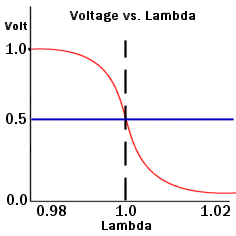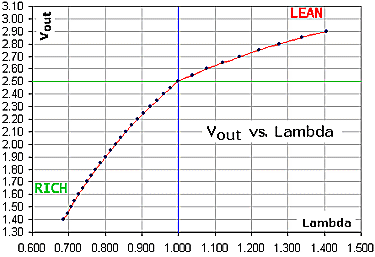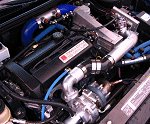

|
Street Class Unlimited Class
DOHC SOHC Ion Updated 1/05 For the most recent list of the fastest five cars click here. |
Oxygen Sensorsby:TitanAn oxygen sensor is the most important sensor on a fuel injected car. Located in the exhaust manifold of the car, its function is to compare the difference in the oxygen content in the exhaust gas against the oxygen content in ambient air. The results are expressed in an analog voltage signal often referred to as Lambda. This information is relayed to the car's engine computer (PCM) which monitors and adjusts the air/fuel ratio accordingly. Cars produced after 1986 have at least one oxygen sensor located in the exhaust manifold and 1996 and newer have at least two sensors, one often located before and after the catalytic converter. A stoichiometric or ideal air/fuel ratio is 14.7:1 which means that there are 14.7 parts of air and one part fuel. The reaction of this mixture would produce emissions that contained only carbon dioxide and water, no fuel or oxygen would be left. At an air/fuel ratio of 14:1 the oxygen sensor voltage signal would read 1.0 volt on a narrow band sensor and 2.5 volts on a wide band sensor. If the air/fuel ratio mixture is rich (more fuel than air) than the sensor would read fewer volts or conversely if the mixture is lean (more air than fuel) the O2 sensor would read a larger voltage. If the air/fuel ratio is richer than 11.7:1 (0.8 volts) or leaner than 18:1 (1.22 volts) the engine won't run.
Narrow Band Sensors
The graph shows voltage vs. lambda. The stoichiometric value for a narrow band O2 sensor is .5 volt indicated where the dashed black line crosses the red solid line. This graph depicts why it is so difficult to tune with a narrow band O2 sensor. As you can see there is a steep rise to the left and a step fall to the right where these two lines intersect. Moving slightly to the left or right (x-axis) of the dashed black line produces a significant y-axis movement. Also, the range of a narrowband sensor is only 0-1 volt which limits the tuning resolution. If your car is running rich all you really can tell is that you are left of where the two lines intersect. Similarly if the car is lean you are to the right of where the lines intersect, this is about as good as you can get with a narrowband sensor. Saturn's are equipped from the factory with a single wire non-heated oxygen sensor. The sensor is grounded by the exhaust manifold while the single wire provides the PCM Lambda information. A non-heated sensor relies on the exhaust gases to keep it at its operating temperature which works most of the time but during extended periods of idling or low speed operation can cause the sensor to drop below its operating temperature and show a false lean mixture. Oxygen sensors must warm up to at least 400 degrees Celsius before generating an accurate signal. This is why cars remain in open loop (preprogrammed fuel map) when the engine is cold and don't switch to closed-loop (relying on the O2 sensor readings) until the engine has warmed up. 3 and 4 wire sensors are heated. One wire sends Lambda information to the PCM while the 2 additional wires are for either additional ground wires or 12v heater voltage (delivering power whenever the ignition is turn on). Heated sensors have several advantages over non-heated sensors. Heated sensors warm up more quickly than non-heated sensors and provide an accurate voltage signal regardless of the operating conditions. Also, with turbo charged cars the turbo absorbs so much heat that it prolongs the oxygen sensor warm-up which can yield false sensor readings. Using a heated sensor is highly recommended for turbo applications and in some cases less expensive than the factory replacement. Wide Band Sensors
*Graph taken from the Mega Squirt website. Sometimes it is desirable to run either leaner or richer than 14.7:1. If your goal is to produce maximal power output of the engine, as with forced induction, you'll want to run a richer air/fuel mixture around 12.5:1. The additional fuel in the cylinder will not burn. For example if we added 2 parts fuel to 14.7 parts air only one part of fuel will burn and do work. This is because there is not enough air to burn the second part of the fuel, remember that one part fuel combines with 14.7 parts air in a stoichiometric reaction. This unburnt fuel takes up valuable space in the cylinder but in forced induction applications cylinder temperatures can skyrocket and cause detonation. This extra fuel provides an anti-knock or cooling effect allowing for more power to be produced. If you ran at an air/fuel ratio of 12.5:1 all the time you would waste a lot of fuel but fortunately you don't need to. Normally it is only necessary to enrich the fuel mixture under load i.e. when boosting or engaging nitrous at all other times it is better to run a little leaner than 14:1. Running a lean air/fuel ratio will improve your gas mileage but be careful if you run too lean you will cause your combustion chambers to overheat. Running lean under power destroys engines because the combustion chambers get so hot that the pistons fall apart under the stress which is mostly due to pre-ignition. This will defiantly make for a bad day very fast.
|
|





